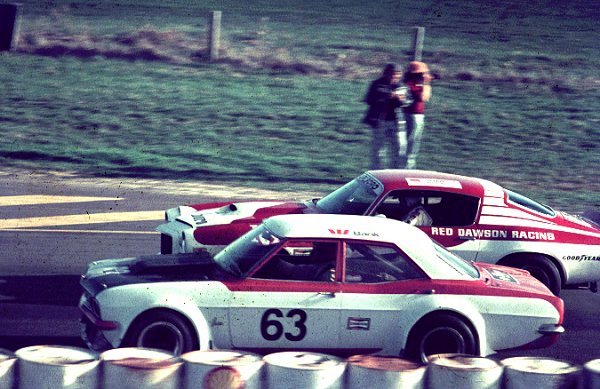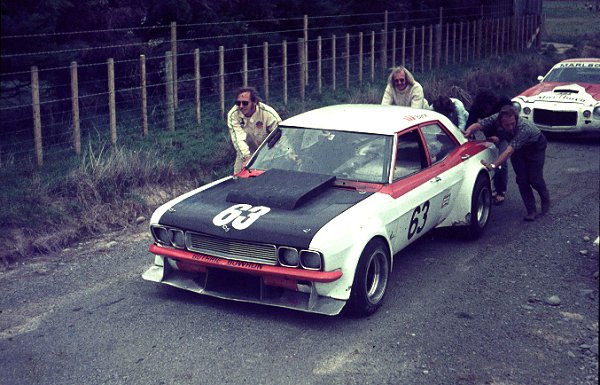-
Administrator

Article: Miss Victorious

This car had a relatively brief career. It raced for just three seasons. Yet, it won the New Zealand Saloon Car Championship twice! For those who saw it race, who felt the ground shake beneath its 600hp Chevy, and watched owner/driver Jack Nazer drag it by the throat as he and arch-rival Leo Leonard pounded on each other, Miss Victorious left an indelible impression. Even today, more than three decades after it last turned a wheel in anger, its still a favourite among Kiwi race fans. Nazer would slug it out with the best of them, and his popularity reached its peak with Miss Victorious.
For Nazer, this was to be his last tilt at the NZ Saloon Car Championship, and other than a couple of years running a speedway Midget car in the early ‘80s, the Victor was the last car he raced. Having launched his racing career in 1961, behind the wheel of a ’38 Chevy coupe, Nazer worked his way through a brace of Ford Anglia’s over the next few years, culminating in a Lotus-propelled example with heavily re-worked body, chopped top, droop-snoot beak, and fastback roof, taking full advantage of the liberal NZ Allcomer rules, with which he attacked the 1967 NZ Saloon Car Championship with gusto. Ultimately, his campaign came up short. After leading the championship early, his challenge ran out of puff, as did that of every other competitor, as Robbie Franicevic got into his stride in the 427ci Galaxie powered Custaxie, which swept to victory in each of the last four races of the seven race season.

With the stroke of a pen, the Allcomers were assigned to the scrap heap following the ’67 season, and New Zealand adopted international Group 5 regulations instead, which were already in place throughout other parts of the world. With this, Nazer ditched the Anglia, which had suffered heavy damage in a late season shunt at Pukekohe. But fortunately the Lotus twin-cam unit up front was salvageable, and transplanted into a MkI Cortina. The Cortina’s brief career ended dramatically in a ball of flames during a nasty shunt in an endurance race at Pukekohe.
Following the Cortina fireball incident, Jack took some time away from racing until returning in 1969 with a self-built twin-cam Escort. Fords Escort TC had proven itself to be a pretty good weapon in British Touring Car racing, and Nazers rival Paul Fahey imported himself a race ready example from Alan Mann Racing, to replace his highly successful Ford Mustang. Several other teams also armed themselves with these giant killers, including young up-and-comer Jim Richards, at the wheel of a John Willment built version. With backing from mens toiletry suppliers Cossack, Nazer made an all-out assault on the NZ Saloon Car Championship over the next two seasons, initially with Twin-cam power, then with a larger FVA, but with the extra power came increased unreliability, which blighted his challenge. Following a frustrating 1971 campaign, Nazer again opted to hang up his overalls and concentrate on his business.

By 1973, with the business doing well and the money rolling in, Nazer decided to have one last fling at the championship that had thus far eluded him. With Motorsport Association of New Zealand having relaxed the saloon car regulations, teams now had many more freedoms than the old Group 5 rules allowed. They could now fit any motor into any car, as long as that motor didn’t exceed 6,000cc, and could be moved back or forward within the bodyshell to better improve weight distribution. Brakes were free, as were wheel sizes. The vehicle silhouette had to remain basically standard, but flares could be added to house wider wheels, and front and rear wings could be added to increase downforce. Thus far, most teams chose to evolve their existing vehicles, rather than start afresh with a clean sheet of paper, and here presented an opportunity for someone to get a jump on the opposition with a purpose-built racer, created to take full advantage of the new regs.
It was during a meeting with Jim Stone that the concept for Nazers ultimate challenger took its first breath. Jim, along with brother Ross, has since gone on to become one of the most successful team owners in Australian V8 Supercar racing, with Stone Brother Racing team. But back in 1973, Jim was just another young bloke looking for work, and to make a name for himself, having just returned from a multi-year stint at team McLaren in the UK as chief engineer.
Jim set about looking for a car with exactly 102” wheelbase, to gain a happy medium between nimbleness and stability. The unlikely FD Vauxhall Victor fit the bill perfectly. Jack also purchased Neil Doyle’s Begg FM2 from which the Chevy motor with quad-Webers, suspension components and McLaren wheels would make their way onto the Victor project. Jim Carlyle would rebuild the Begg motor. They also had a larger 355ci motor assembled at McLaren Engines in the US, which produced 540hp on the dyno. A GM gearbox and diff were used, and other parts came from Frank Radisich’s McLaren M10A.

Initially, the car was fitted with the 5.0 litre Chevy from the Begg, with the new engine arriving early in 1975 from the US. Some basic flares were added, following the radius of the wheel openings, to cover the big McLaren wheels, while beneath the nose sat a flat-pane apron spoiler with a ducting hole in the centre to supply gulps of fresh air to the radiator, and brake-ducting inlets either side. No rear spoiler was used. For its first season, the Victor was painted white and red, with matt-black hood.
The Victor was completed in time for the start for the 1974/75 NZ Saloon Car Championship. With expectations high, the team were brought back down to earth with a thud at the opening round. In a 1976 interview with Motorman magazine, Jack was quoted as saying, “It felt like a lethal missile. It handled atrociously and was very unstable under braking”. The new machine threw up a myriad of problems, with front suspension issues creating the braking drama’s, and the Begg Chevy produced its power all at once with a bang, so Nazer must have felt like he was riding a wild horse. To top off the weekend, a rear axle broke. Despite its adventurous first event, Jack could see the car had potential.
 Posting Permissions
Posting Permissions
- You may not post new threads
- You may not post replies
- You may not post attachments
- You may not edit your posts
-
Forum Rules






 Reply With Quote
Reply With Quote